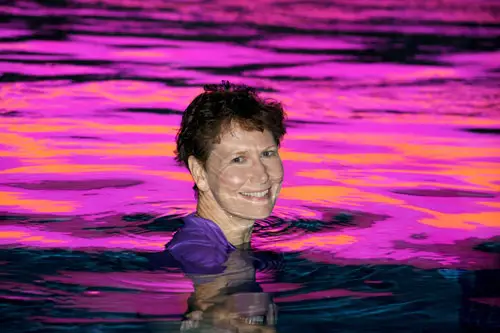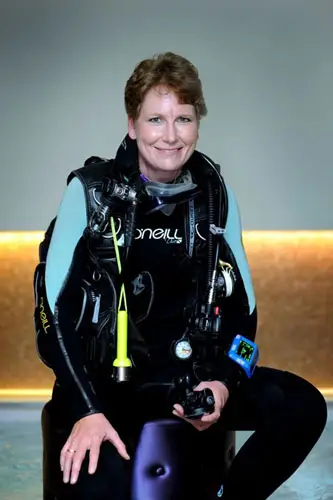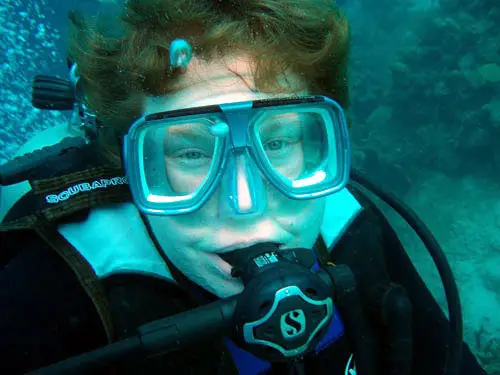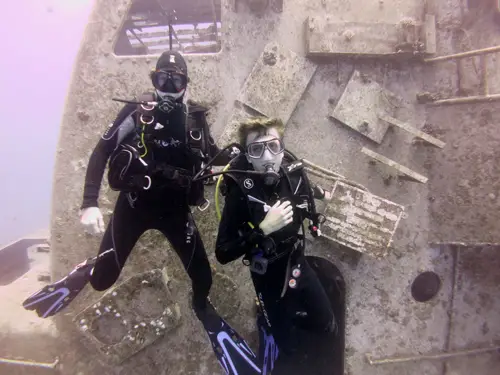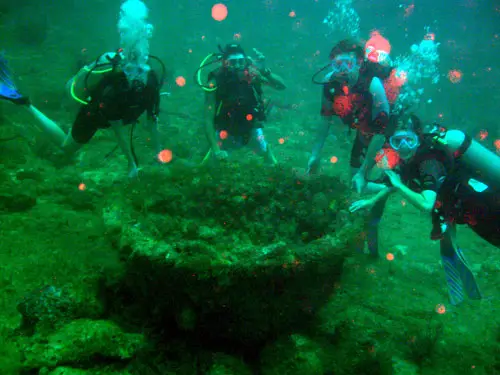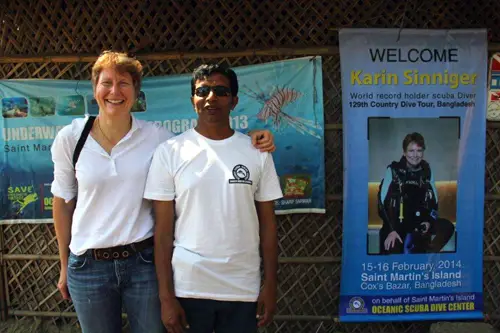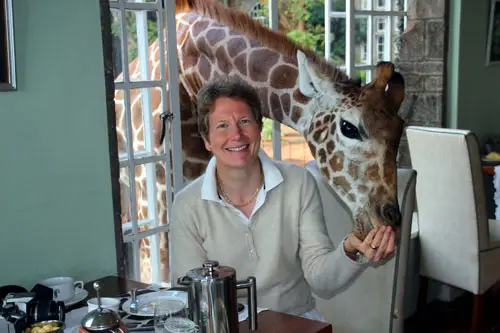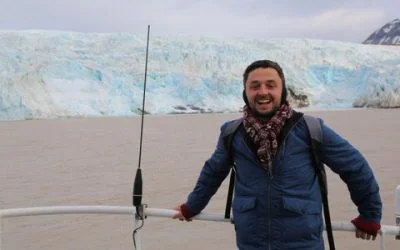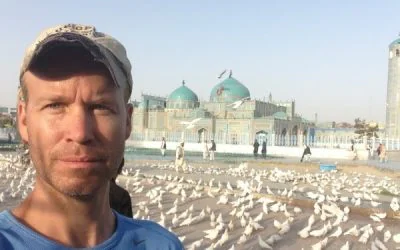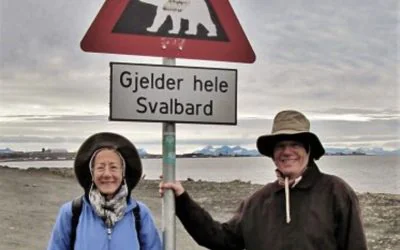Karin, you hold the world record for dives in most countries in the world. Tell us a little about the background to your interest in diving, how you got the idea to try diving ‘everywhere’ and where you still feel you would like to dive.
It was on a rough patch of the Indian Ocean enroute from the Seychelles to the Chagos Islands in 2005 that I got the idea of combining my twin passions of diving and globe trotting. I sat in the cabin of the Indian Ocean Explorer trying to stave off sea sickness and started talking with David Langan, also a member of the The Best Travelled.
Most of the passengers were British retirees interested in the bird life on these uninhabited islands. But David, a Dubliner who ran a successful chain of furniture stores in the Emerald Isle, was going to the Chagos Islands because he is a country collector.
“Stamp collecting takes me to these places”, David explained. “I don’t consider I’ve been to a country unless I send a postcard from there. I have to research the addresses and opening times of the post office in every country I plan to visit. It’s a challenge but I love it. I come from a very poor family and left school at 15. Traveling and stamp collecting have been like universities to me, opening the door to history, culture, geography and people.”
Hmmm. If David could visit countries to send postcards, why couldn’t I combine country collecting and diving? Intrigued, I asked David to go through the list of countries he had stored away in his Palm pilot, and was pleasantly surprised to find that I had been to over 100 countries and was thus qualified to join the TCC.
Hitherto, I’d only dived in about thirty countries, but having made the decision to try and dive in every country I visited, I quickly racked up new dive destinations. No matter what the season, I would tack on a few days at the beginning or end of every business trip and dive in a nearby country. This sometimes meant I was diving countries like Iceland in the dead of winter, so my dry suit skills sharpened. I looked for opportunities to dive numerous neighboring countries at the same time and found “quick” hits in the Caribbean, Arabian Gulf and Europe. I scoured the web for details of dive destinations and dive operators. I pleaded with clubs doing a dive to let me join them even though I wasn’t a member. I chartered dive boats just for myself when the operator wouldn’t go out without other passengers.
I decided that when I had dived in a hundred countries I would set up a web site. Seven years after my fateful meeting with David, I achieved my goal. In 2013 I set the world record for diving in the most countries in the Andaman Islands, diving with an elephant. It was the 125th country I dived in.
I now fantasize about flying a compressor, tanks and scuba gear into countries like Iraq, Somalia and Afghanistan and writing about my experiences. It’s so much fun I can’t stop! I love getting e-mails every morning from dive operators in distant countries I have yet to visit with their local greetings: the hearty “Bula” from Fiji, “Talofa” from Samoa and melodic “ia ora na” from French Polynesia. So exotic and inviting.
For the benefit of those of us who know nothing about diving, what are the differences of a dive in, say, Antarctica, Maldives or the Mediterranean in terms of your own preparation for them and then what you are likely to experience.
Antarctica is obviously very cold—the water there is the coldest on the planet at -1C. So you need good thermal protection both in the water and outside the water. Divers wear a waterproof dry suit with layers of thermal pants and sweaters and a kind of thick ski on top of all the thermal lawyers to prevent hypothermia. Many also wear a full face mask to protect the face from the cold and waterproof gloves. It is also essential to have a regulator with a special environmental seal to breathe through as otherwise your breathe can cause the regulator to freeze and block the circulation of air to your mouth. But even with an environmental seal you can get a frozen regulator on the surface. That is why having some boiling water is useful. It is also helpful to warm up cold hands after a dive! Finally, if where you dive has ice, then you need tools to drill a hole in the ice, and ropes to tether yourself to your dive buddy and someone who stands on the surface by the ice hole. That person is called a “tender” and there to ensure you can find your way out of iced up water again—otherwise you die. If you run into trouble during a dive, you yank on the rope connecting you to the tender and he or she must haul you in as fast as possible. It is also quite fun to arrange with the tender (so the tender knows it is not a real emergency) to do this at the end of a dive—you can put your fins against the ice and it feels like upside down skiing or flying to be hauled in so quickly to safety over the icy bumps!
You might see kelp, penguin, leopard seals and the lovely play of light against ice on such a dive.
Maldives: its tropical diving (about 29 C) so some divers dive with nothing but their bathing suits. I get very cold if the water is less than body temperature, so you will always find me with a thick wet suit (unlike the dry suit mentioned above a wet suit is not waterproof. A wet suit keeps you warm by trapping a layer of water against your skin. But after time, every diver will get chilly as long as the water temperature is below body temperature. I have only once dived in water at close to body temperature and that was in Farasan Banks, Saudi Arabia—we sweated as we dove!
Other than that, not much preparation is required for a tropical dive. Tropical diving means colorful reef (if the reefs are in good health and unaffected by global warming or the introduction of foreign species that kill a reef’s habitat -e.g. the introduction of lion fish in bodies of water other than the Pacific Ocean where they have no groupers to keep the lion fish in check.) The Maldives are also known for whale shark sightings and mantas at certain times of the year. I once had the privilege of experiencing about 50 mantas pirouetting around two whales harks in the Maldives.
In the Mediterranean, you can dive without a dry suit but do need a wet suit to protect yourself from the cold, unless you are a really hardy diver diving in late summer. Personally, I dive with a dry suit in the Med. There is no longer much fish life in the Med. due to overfishing, so ship wrecks and caves (such as in Malta) are the main attractions.
What are the safety requirements for the dives you do? What makes a dive a ‘success’ or not so much of a success?
I used to do complex cave dives, ice dives, wreck dives and ice dives. You need specialized training for these types of dives as well as mixed gases to reduce your risk of decompression sickness.
Coming back alive always counts as a successful dive but having a unique experience such as interacting with rare marine life or coming back from a deep cave or wreck dive which few in the world will have the privilege to see is an added bonus. Here are two dives which I enjoyed least. The next question will give examples of dives I liked more.
Cement Barge, Dubai: Strap on your scuba tanks and walk into a sandstorm (from all the land reclamation and building activity), add water, pay through the nose for the privilege and you get diving in Dubai. Oh and think about bringing a dry suit in winter since the water is a chilly 17C.
Amphorae Bay, North Cyprus in a squall: You have to be desperate to get wet or working on setting a dive record to attempt this. The dive operators are top notch and give you fair warning that all you will see is sand and don’t recommend this. But if you have the skills and the will, they will take you out. Unlike Dubai the prices won’t make your nose bleed. If there is no squall the diving is average rather than poor and Cyprus gets high marks for having one of the longest diving seasons in the Mediterranean.
If you had to propose three great dive sites for the advanced diver, which ones would make the cut?
Bahamas: Andros Island blue hole caves. Incredible light and beauty but deep and complex. Can only be dived twice a day at about 2 PM and 2 AM due to currents. You need advanced cave dive training and mixed gas training.
Solomon Islands: They have it all: a great liveaboard dive operator (Bilikiki Cruises); interesting top side scenery and culture to visit during the day in between dives; macro diving where you can photograph small critters like the colorful mandarin fish; superb pelagic dives with schools of barracuda and jacks.; colorful reefs in good health. They used to have good shipwreck diving too before volcanic eruptions.
SS Coolidge, Santo, Vanuatu: Scale, depth and artifacts, the Coolidge has it all. And it’s easily accessible both in terms of location (just a short swim from a beach) and for all experience levels. Pick a dive from 20-70 meters on the mammoth 654 foot ship. You can dive tech if you want to, but most divers stick to large tanks and an extra pony bottle for deep dives. Personalized dive-guiding means that you keep the same dive guide for the length of your stay and will rarely dive with more than one other diver. Just tell your dive guide what floats your boat and then dive it. The dusk dive at 40 meters with the flashlight fish is an other-worldy experience—like floating in space with thousands of stars around you. I didn’t shower for a day after that dive just to keep the smell of the salt on my body to remember it, it was that good.
And what about the novice? How and where should they start?
Mambo or Likoma Islands, Lake Malawi, Malawi: Seas will always have the edge over lakes when it comes to corals, color or variety of critters, but Africa’s third largest lake is one of the most relaxing places in the world to dive. Learning to dive there is inexpensive and you can dive from shore so the diving is very easy. Waters are clear, warm and teeming with huge catfish (1-2 meters), fighting crabs and brightly colored cichlid fish that are popular for aquariums. The sound of waves lapping the golden shore will lull you to sleep and you will wake to the sound of women doing their laundry along the lake shore and fishermen returning with their catch. Electricity is still rare so you can witness a centuries old way of life, but comfy and well priced eco lodges mean you don’t need to sacrifice comfort. Finally, the Malawians are so friendly their country is known as the “warm heart of Africa”.
Another good place to learn how to dive is in Honduras as it is inexpensive and there is much to see in terms of coral reefs and whale sharks.
You have travelled much as a result of your interest in diving. In terms of countries, which ones have surprised you (positively or negatively) compared to what you expected before going there?
I spend a lot of time researching destinations before reaching them so I am not usually surprised by what I find.
I do have a few observations, however:
I cut short my first trip to Israel 30 years ago despite the wealth of history and cultures to experience there. It was at the height of the intifaddah and while I found the Palestinians to be friendly, I found the sabras (Israeli Jew born on Israeli soil) to be less so. They are said to be like the cactus—prickly on the outside and soft on the inside, and I only experienced the prickly side. I took my nephew and niece to Israel three years ago and found the people to be much friendlier and consequently had a more positive experience.
Namibia was also a revelation. I was lucky to experience a flying safari around that vast country and having a passionate guide who showed us the life teeming in a desert that looked dead and how wonderfully adapted every animal, insect and plant is. No amount of reading can replace experiencing that first hand.
Finally, wherever I am in the world, it is usually those who have the least, who seem to be the most generous either with their time in giving me directions, inviting me to their homes to sleep or share a meal with them or buying a bus ticket or museum entrance ticket for me.
How do local people react when they hear about your experiences? Any notable reactions?
I usually don’t volunteer how much I travel or my dive record as I have learned that people prefer telling you about their travel experiences than hearing about yours.
However, on a dive boat people usually find out and this leads some divers or dive resorts to request a photo with me.
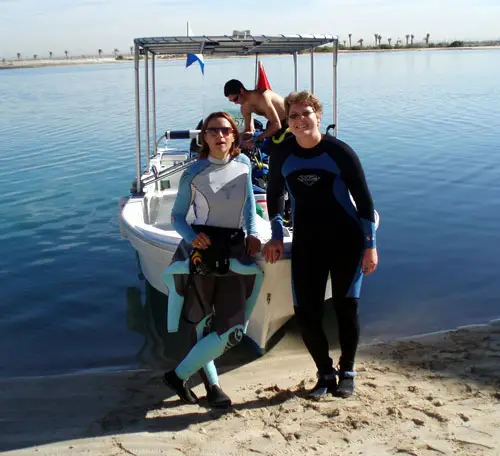
Preparing for a dive in Abu Dhabi
Of the countries you have not visited yet, which ones are on your bucket list?
I’m looking forward to visiting Mongolia next year for the Naadam Festival. Diving wise, I would like to dive in Somalia but I would need to fly in a tank and compressor and would require many body guards on the beach—but I keep hoping!
You currently live in South Africa. Any hidden gems there that are not widely known to the public?
South Africa has some excellent diving and tourism opportunities which are well known. The most unique opportunity I had there was to join the owners of a diamond concession on the Atlantic Ocean at Port Nolloth and dive for diamonds. The diving is so tough they can only go out less than 10 days a year. It makes you realize how precious diamonds are and how much blood and sweat go into finding them.
Tell us a little bit about your website and what your aims with it are.
My website is www.diveandtraveltheworld.com. I set it up to chronicle my underwater life and give other divers guidance of unique places they could dive which were not mentioned in dive magazines. Many places around the world can’t afford to pay dive magazines for advertising. The places that can afford to pay for advertising are often places that used to be great dive destinations 20-30 years ago before global warming, coral reef degradation or mass tourism negatively impacted them. Since they pay the dive magazines they still get the favorable publicity though. My travels and website is entirely self-funded and I accept no freebies in exchange for favorable coverage so I write about what I truly experience.
And finally a question we like to ask – if you could invite 4 people from any period in human history to a dinner, who would they be and why?
John Lennon: Love his music.
Wilfred Thesiger: unafraid to live an explorer’s life on his terms. Excellent at seeing the world through the eyes of local inhabitants and writing about this with such clarity.
Elizabeth I: a woman who was a great ruler in a man’s world.
Nelson Mandela: from prisoner to president and world icon for peace, tolerance and forgiveness. I would like some of these qualities to rub off on me.
The photographs accompanying this interview are from Karin’s private collection.
